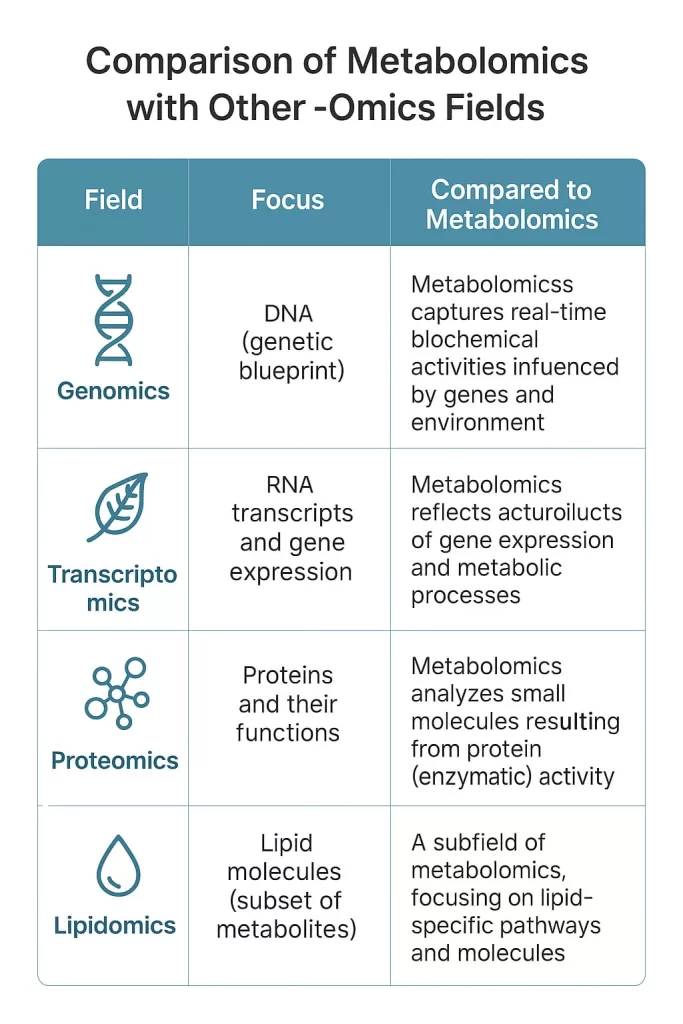Metabolomics is an relatively young field in life sciences focused on the comprehensive study of metabolites, especially within biological systems. It provides unique insights into cellular processes, disease mechanisms, and responses to environmental changes. Unlike genomics, transcriptomics, and proteomics—which study genes, RNA, and proteins respectively—metabolomics offers a real-time snapshot of biochemical activity, making it valuable for personalized medicine and drug development.
What is Metabolomics?
Metabolomics is the large-scale study of small molecules, known as metabolites, within cells, tissues, or biofluids. These metabolites serve as direct indicators of physiological states and biochemical reactions, offering a dynamic view of an organism’s metabolism.
What is Metabolomics and its applications?
Key Analytical Techniques in Metabolomics
Several sophisticated analytical methods enable researchers to identify and quantify metabolites:
Mass Spectrometry (MS): Enables identification and quantification of metabolites with high sensitivity. It is typically used as a tandem MS, i.e. in conjunction with pre- separation:
- Liquid Chromatography-Mass Spectrometry (LC-MS): A widely used technique for metabolite profiling that handles complex samples with high sensitivity.
- Gas Chromatography-Mass Spectrometry (GC-MS): Ideal for analyzing volatile and thermally stable metabolites, commonly used in environmental and food sciences.
Mass Spectrometry in Metabolomics
Applications of Metabolomics
Metabolomics has broad applications across scientific and medical fields:
- Biomarker discovery for disease diagnostics: Identifying metabolic signatures that help in early disease detection and monitoring treatment effectiveness.
- Personalized medicine and drug response studies: Tailoring medical treatments based on individual metabolic profiles to enhance efficacy and reduce adverse effects.
- Nutritional and environmental impact assessment: Evaluating how diet and environmental factors influence metabolism and overall health.
- Functional genomics and metabolic engineering: Assisting in the development of genetically modified organisms and optimizing metabolic pathways for industrial and pharmaceutical applications.
Key Differences Between Metabolomics and Other -Omics Sciences
Understanding how metabolomics differs from other -omics sciences is crucial for leveraging its full potential in research and applications.

- Genomics vs. Metabolomics
- Genomics studies the complete set of DNA in an organism, providing a static blueprint of genetic potential.
- Metabolomics examines the actual biochemical activities occurring in real time, influenced by both genetic and environmental factors.
- Key Difference: Genomics provides potential insights, whereas metabolomics reveals real-time physiological states.
- Transcriptomics vs. Metabolomics
- Transcriptomics focuses on RNA transcripts and gene expression regulation.
- Metabolomics reflects the end products of gene expression and metabolic reactions.
- Key Difference: Transcriptomics predicts cellular activity, while metabolomics captures
the outcomes of biochemical processes.
- Proteomics vs. Metabolomics
- Proteomics investigates proteins, their structures, and functions.
- Metabolomics studies the small molecule products of enzymatic activities.
- Key Difference: Proteomics focuses on biological machinery, while metabolomics highlights the functional outcomes of biochemical pathways driven by this machinery.
- Lipidomics as a Subfield of Metabolomics
- Lipidomics is a specialized branch of metabolomics focusing on lipid molecules.
- Lipids (hydrophobic molecules with well-defined structural patterns) play crucial roles in cellular signaling, energy storage, and membrane structure.
- Key Difference: Lipidomics is a subset of metabolomics but has distinct methodologies
and applications.
| Field | Focus | Compared to Metabolomics | Key Difference |
|---|---|---|---|
| Genomics | DNA (genetic blueprint) | Metabolomics captures real-time biochemical activities influenced by genes and environment | Genomics shows potential, metabolomics shows current physiological state |
| Transcriptomics | RNA transcripts and gene expression | Metabolomics reflects actual products of gene expression and metabolic processes | Transcriptomics predicts activity, metabolomics measures outcomes |
| Proteomics | Proteins and their functions | Metabolomics analyzes small molecules resulting from protein (enzymatic) activity | Proteomics reveals machinery, metabolomics reveals functional results |
| Lipidomics | Lipid molecules (subset of metabolites) | A subfield of metabolomics, focusing on lipid-specific pathways and molecules | Lipidomics is specialized, with unique methods and applications |
Complementarity of Omics Sciences — The Systems Biology Approach
Rather than working in isolation, omics disciplines complement each other to provide a holistic understanding of biological systems. Systems biology integrates genomics, transcriptomics, proteomics, and metabolomics to uncover complex biological interactions.
For example:
- In drug development, metabolomics helps assess drug efficacy and toxicity by analyzing metabolic changes.
- In cancer research, multi-omics approaches identify molecular signatures that guide targeted therapies.
Future Directions and Challenges in Metabolomics
Challenges in Metabolomics
- Data complexity and standardization: The vast diversity of metabolites requires advanced analytical and computational techniques.
- Integration with other omics data: Combining metabolomics with genomics and proteomics remains challenging due to data heterogeneity.
Future Prospects in Metabolomics
- Artificial Intelligence and Machine Learning: AI-driven models can enhance metabolite identification and biomarker discovery.
- Precision Medicine: Metabolomics will likely play an increasing role in tailoring medical treatments to individual metabolic profiles.
- Environmental and Nutritional Sciences: Expanding metabolomics applications in agriculture and food safety shows promise.
Conclusion
Metabolomics stands out among omics sciences by providing real-time insights into biological functions and disease states. While genomics, transcriptomics, and proteomics lay the foundation for understanding genetic and protein-based mechanisms, metabolomics captures the dynamic metabolic responses of an organism. As technology advances, the integration of metabolomics with other omics fields continues to evolve biomedical research, contributing to advancements in personalized medicine, drug discovery, and systems biology.
